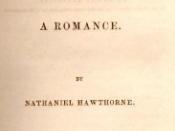In Nathaniel Hawthorne's The Scarlet Letter, Hester Prynne's scarlet token liberates her more than it punishes her. First of all, Hester's soul is freed by her admission of her crime; by enduring her earthly punishment, Hester is assured of a place in the heavens. Also, though her appearance is much hampered by the scarlet letter, her mind is freed by it, that an intellectual passion rises from her isolation and suffering. Finally, it defines her identity, for the letter makes Hester the woman that she is; it gives her roots, character, and a uniqueness to her being that sets her apart from the other Puritans. The scarlet letter is indeed a blessing to Hester Prynne, more than the curse she believes it to be.
The scarlet symbol of ignominy may have defiled Hester's public image, yet it has been a benefit rather than a bane to her soul, for by admitting her crime to the crowd, her soul is freed from two hells: first, the fiery pit where she would otherwise go after death, and second, the own personal hell Hester will create for herself if she had chosen to hide her sin in her heart.
Though it was ordered for Hester to wear the letter, it was still her own choice to make it in a vivid scarlet, 'so fantastically embroidered and illuminated upon her bosom.' Hester chose red as the color of her brand of shame, to declare to the rest of the townspeople that she is prepared to acknowledge her sin, instead of denying it; she could have chosen to wear her 'A' in a plain and nondistinct color, to escape the townspeople's disdain. By displaying her guilt however, she is granted the opportunity to face her punishment bravely, thus through her public humiliation,



The Scarlet Letter
This is an excellent essay. You have a very complex thesis and a very good argument. I cannot believe how eloquent all of your sentences are! This is very inspirational, and has a very deep analysis of the text. Wow.
0 out of 0 people found this comment useful.